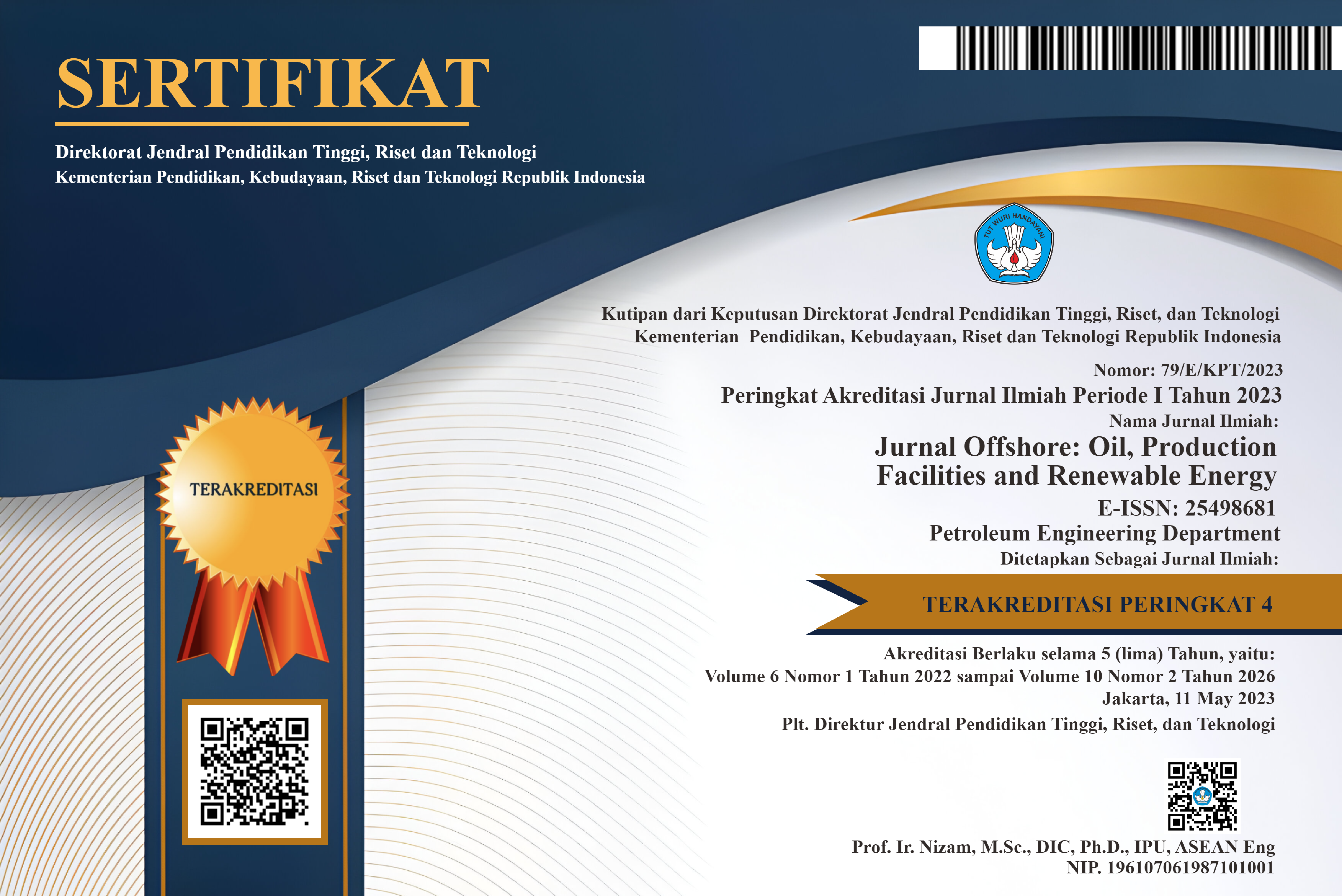Pemodelan Intensitas Rekahan pada Fractured Basement Reservoir dengan Pendekatan Konsep Geologi Menggunakan Analisis Kualitatif di Cekungan Sumatra Tengah
DOI:
https://doi.org/10.30588/jo.v2i1.347Keywords:
batuan dasar, fractured, reservoir, rock bottomAbstract
Lokasi Penelitian terletak di Selat Malaka dan termasuk dalam Cekungan Sumatra Tengah. Secara stratigrafi, Batuan Dasar Cekungan Sumatra Tengah berumur Pra Tersier dengan litologi batuan sedimen yang termalihkan atau metasedimen. Berdasarkan data sumur pemboran, batuan dasar di lokasi penelitian secara umum berupa kuarsit dan filit. Rekahan pada batuan dasar dikontrol oleh periode tektonik regional yang mempengaruhi Sumatra. Sesar-sesar yang terbentuk berarah umum Utara Barat Laut – Selatan Tenggara (NNW – SSE), hasil dari fase tektonik selama Paleogen hingga Neogen yang menghasilkan morfologi batuan dasar beragam akibat adanya horst graben dan half graben. Morfologi tinggian adalah yang berpotensi menjadi reservoir karena batuan induk yang terletak lebih rendah akan memungkinkan migrasi hidrokarbon. Identifikasi rekahan batuan dasar dianalisa berdasarkan data pemboran sumur dan seismik. Intensitas rekahan dibangun berdasarkan model dengan pendekatan 4 parameter geologi yaitu intensitas rekahan dengan jarak dari bidang sesar, intensitas rekahan dengan pucak antiklin, intensitas rekahan dengan jarak dari permukaan batuan dan dibantu dengan atribut seismik. Nilai intensitas yang memungkinkan terbentuk rekahan adalah 0,3-1.
The research site is located in the Malacca Strait and is included in the Central Sumatra Basin. Stratigraphically, the basement of the Central Sumatra Basin is Pre-Tertiary with thermal sedimentary or metasediment lithology. Based on data from drilling wells, bedrock in the study site generally consists of quartzite and filite. Fractures in bedrock are controlled by regional tectonic periods affecting Sumatra. Faults that form are generally north-north-south-south (NNW-SSE), resulting from tectonic phases during Paleogene to Neogene which produce various bedrock morphologies due to horst graben and half graben. Height morphology is the potential to be a reservoir because the source rock which is located lower will allow hydrocarbon migration. Identification of basement fractures was analyzed based on well and seismic drilling data. The fracture intensity was built based on the model with a 4 geological parameter approach, namely fracture intensity with distance from the fault plane, fracture intensity with anticline peaks, fracture intensity with distance from the rock surface and assisted with seismic attributes. The intensity value that allows the fracture to form is 0.3-1.
References
Aguilera Roberto. 1995. Naturally Fractured Reservoirs. Pennwell Publishing Company, Tulsa, Oklahoma, United State of America. 540 hal
Dershowitz, B., LaPointe, P., Eiben, T. & Lingli Wei. 2000. Integration of discrete feature network methods with conventional simulator approaches. SPE 62498
Guttorsmen Joel. 2010. Naturally fracture Basement Reservoirs: Using South Sumatra To Characterize The Challenges Of Exploring And Exploiting Fracture Basement Resrvoirs . Proceedings of Indonesian Petroleum Association 34th, IPA 10-G-183, 15 hal
Heidrick. T. L., Karsani Aulia. 1993. A Structural and Tectonic Model of The Coastal Plains Block, Central Sumatra Basin. IPA Annual Convention, Indonesia.
K. J. W. Mc Caffrey, J. M. Sleight, S. Pugliese, R. E. Holdswoth. 2003. Fracture Formation And Evolution In Crystaline Rock : Insight From Atribute Analysis. Geological Society, London, Special Publication, 109-124
Louis H. 1980. The Reservoirs Engineering Aspect Of Fracture Formation. Institut Francais Du Petrole, Ecole Nationale Superiure Du Petrole Et Des Moteurs, Paris, France
Nelson R.A, 2001. Geologic Analysis Of Naturally Fractured Reservoirs. Gulf Publishing Company, Houston, Texas, United State of America, 350 hal
Stearns, D.W. & Friedman, M. 1972. Reservoirs in fractured rocks. In: Kling, R.E. (ed), Stratigraphic oil and gas fields: Classification, exploration methods and case histories. American Assoc. Petroleum Geol. Publ., Mem. 16, 82-106.
Van Golf Racht. T.D. 1982. Fundamental Of Fracture Reservoir Engineering. Elsevier Scientic Publishing Company, Amsterdam, Netherland
Downloads
Published
How to Cite
Issue
Section
License
Authors retain copyright and grant the Jurnal Offshore right of first publication with the work simultaneously licensed under a Creative Commons Attribution 4.0 International License that allows others to share (copy and redistribute the material in any medium or format) and adapt (remix, transform, and build upon the material) the work for any purpose, even commercially with an acknowledgement of the work's authorship and initial publication in Jurnal Offshore. Authors are able to enter into separate, additional contractual arrangements for the non-exclusive distribution of the journal's published version of the work (e.g., post it to an institutional repository or publish it in a book), with an acknowledgement of its initial publication in Jurnal Offshore. Authors are permitted and encouraged to post their work online (e.g., in institutional repositories or on their website) prior to and during the submission process, as it can lead to productive exchanges, as well as earlier and greater citation of published work (See The Effect of Open Access).















